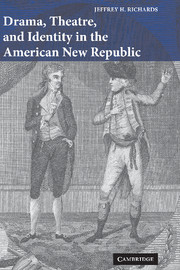Book contents
- Frontmatter
- Contents
- Acknowledgements
- Introduction
- 1 American identities and the transatlantic stage
- PART I Staging revolution at the margins of celebration
- PART II Coloring identities: race, religion, and the exotic
- 7 Susanna Rowson and the dramatized Muslim
- 8 James Nelson Barker and the stage American Native
- 9 American stage Irish in the early republic
- 10 Black theatre, white theatre, and the stage African
- PART III Theatre, culture, and reflected identity
- Notes
- Bibliography
- Index
8 - James Nelson Barker and the stage American Native
Published online by Cambridge University Press: 22 September 2009
- Frontmatter
- Contents
- Acknowledgements
- Introduction
- 1 American identities and the transatlantic stage
- PART I Staging revolution at the margins of celebration
- PART II Coloring identities: race, religion, and the exotic
- 7 Susanna Rowson and the dramatized Muslim
- 8 James Nelson Barker and the stage American Native
- 9 American stage Irish in the early republic
- 10 Black theatre, white theatre, and the stage African
- PART III Theatre, culture, and reflected identity
- Notes
- Bibliography
- Index
Summary
In staging north africans – undifferentiated “moors” – Susanna Rowson became one of the first American playwrights to construct non-white, non-Christian characters for the stage, and she did so by beginning with types and situations with which transatlantic audiences were long familiar. Even in the decade or so after Rowson, there were relatively few enacted American plays with figures representing persons of color from outside of the world of Euro-American elites and their African American servants. Despite Natives' significance to American history and their place in such genres as the captivity narrative, Indian characters made virtually no appearances in stage plays by Americans before 1800; Ann Julia (Kemble) Hatton's 1794 Tammany; or, The Indian Chief is the rare exception, but its text has not survived. There were other outlets for depiction of Native peoples, including in such novels as Charles Brockden Brown's Edgar Huntly (1799) or Rowson's Reuben and Rachel (1798), and by the 1790s, most prose accounts of Indians depicted them as one-dimensional savages. Of course, theatregoers in the new republic might have encountered stage Indians in dramas by Europeans; and in both the colonial and early national periods, Native chieftains sometimes attended the theatre when in New York, Philadelphia, or later in Washington on diplomatic business, giving local spectators opportunities to see them in person. By 1850, that would change; attendants at the American stage would have been well used to Indian dramas, even surfeited by them; but in the early republic, the presentation of the Native figure created a number of problems and anxieties for playwrights and managers in terms of how a people, framed so frequently as the savage enemy, would be represented before post-Revolutionary audiences.
- Type
- Chapter
- Information
- Drama, Theatre, and Identity in the American New Republic , pp. 166 - 187Publisher: Cambridge University PressPrint publication year: 2005



